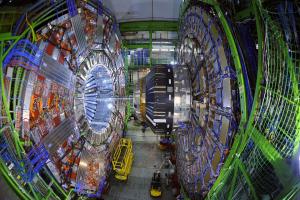Blog
Technicolor Dreams
15 November 2014
 CERN
CERNThere’s been some buzz recently about doubts regarding the existence of the Higgs boson. The popular press has picked up on this a bit, leading to claims that it’s similar to the BICEP2 debacle. In this case the comparison is unfounded. There’s been some interesting work, but nothing that merits tracking down Peter Higgs and taking back his Nobel prize.
The buzz is based upon a new article in Physical Review D claiming there isn’t enough evidence to support the Higgs over other alternatives.1 That might sound similar to the BICEP2 case for cosmic inflation, but it isn’t. The “alternatives” presented in the paper involve an extension of the standard model known as technicolor. The name derives from the standard model of particle physics, where the quarks that comprise protons and neutrons (among other particles) interact through strong nuclear “color” charges. Technicolor models extend the color model, hence the name.
Technicolor models were developed to address certain difficulties in the standard model, such as symmetry breaking in the weak nuclear force, through which particles can gain mass. In the standard model the Higgs field is used as the mass mechanism, but in technicolor models it is done by technicolor gauge particles. It all gets pretty complicated, but the upshot is that in the technicolor model there isn’t a Higgs boson, and particle mass is generated by other means.
But given that we’ve discovered the Higgs boson, and even awarded Nobel prizes for it, doesn’t that mean the technicolor models must be wrong? Not necessarily, which is what this paper is about. Although the Higgs boson doesn’t exist as a fundamental particle in technicolor models, there are ways that technicolor can produce a composite particle that looks similar to the Higgs, which the authors call a techni-Higgs. Just as a proton is made of quarks, a techni-Higgs is made of techni-quarks.
What the authors show is that the data we have so far isn’t sufficient to distinguish between the Higgs and the techni-Higgs. While that’s true, it isn’t enough to cast doubt on the Higgs at this point. While there are some theoretical advantages to technicolor, there is currently no experimental evidence to support it. This kind of work is worthwhile because it helps prevent us from assuming too much about the data we have, but just because what we’ve discovered could be a techni-Higgs, doesn’t mean it is.
So there’s no reason to doubt the Higgs yet, and supporters of this alternative model can continue to have technicolor dreams.
Belyaev, Alexander, et al. “Technicolor Higgs boson in the light of LHC data.” Physical Review D 90.3 (2014): 035012. ↩︎